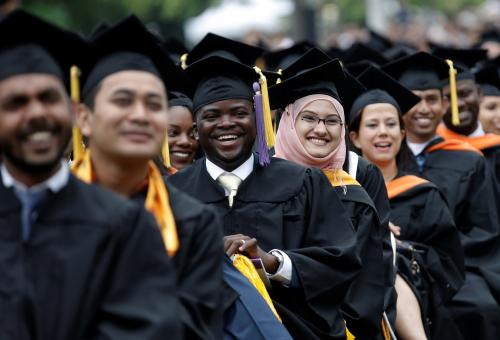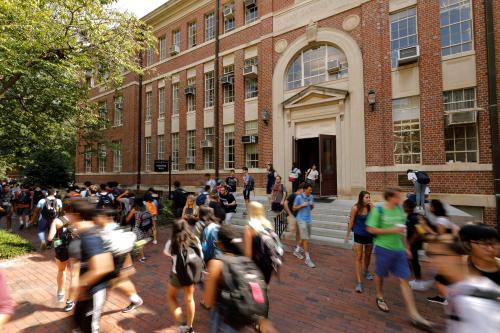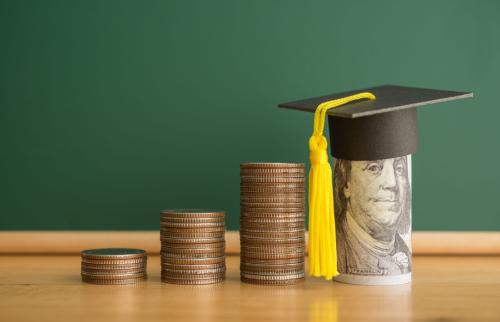This publication was originally produced as remarks given at the release of Indicators of Higher Education Equity in the United States — 2019 Historical Trend Report on Thursday, May 23 at the National Press Club.
For those who seek higher education, access to a college is no longer an insurmountable problem. With more than 5,000 colleges and universities dotted across the United States, and the availability of online and distance learning, more students can find their way into a college classroom than ever before.
Yet close inspection reveals that there is a big assumption in our everyday thinking about higher education that is riddled with faults: the idea that individuals choose the colleges they attend. Yes, individuals must fill out an application and enroll in an institution. But true choice can be out of reach. Students’ college options can multiply based on the family they were born into, the neighborhood they live in, and the schools they attended—and none of these factors are in their control.
A new report was released today by the Pell Institute, an education think tank that conducts research on first-generation college students, and PennAhead, a University of Pennsylvania research group. It found that among the 2009 cohort of ninth graders—who graduated from high school as seniors in 2013—students from the highest socioeconomic quintiles were eight times as likely to attend a “most” or “highly” selective college as those from the lower economic quintile (33% versus 4%). Moreover, students who attended four‐year institutions were more likely to graduate, giving them more opportunities than their peers who attended two-year colleges.
While most students can get into some form of postsecondary institution, low-income students don’t have the same options as their wealthier peers.
While most students can get into some form of postsecondary institution, low-income students don’t have the same options as their wealthier peers. In JK Rowling’s famous novels, when Harry Potter goes to buy a wand, the shop’s proprietor Mr. Ollivander tells him, “The wand chooses the wizard, Mr. Potter.” In the Potterverse, this wasn’t a bad thing. But what if you were a wizard who desperately wanted a wand that didn’t want you back? Substitute colleges for wands, and you have our higher education system.
College admissions leaders talk about creating a diverse campus, but their decisions don’t back up their words. The numbers in this new report don’t lie. In the 2009 cohort, a shocking 73% of rich kids, those in the top economic quintile, got into four-year colleges as compared to a paltry 25% the poor kids in the bottom quintile. Somehow, the wands are not picking the lower-income wizards.
Colleges and universities use specific admissions criteria, highly influenced by standardized test scores, which limit options for low-income students who tend to score lower on these kinds of tests. In other words, colleges and universities are picking students just as much as (or maybe more than) students are doing the selecting.
In addition to institutional admissions criteria, performance-based funding policies require that colleges meet certain goals in order to increase their tuition rates or receive more state funding. In the last decade, a wave of performance-based polices have been codified into state law across the country. As of September 2016, “[t]hirty-one states use performance-based budgeting for at least a portion of higher education funding,” according to the National Conference of State Legislatures. For instance, the Louisiana Grad Act gave Louisiana colleges more freedom to increase tuition in exchange for higher academic performance.
The unintended consequences of policies like the Grad Act are that many state schools have had to institute significant restrictions on their admissions, including setting minimum ACT or SAT requirements. This means that states are creating policies that sort students into different college types based on test scores. Low-income students who didn’t have the luxury of being born into wealthy families are funneled into two-year colleges and upper-income students have the privilege of attending a four-year flagship institution. This sorting renders the idea of student choice a fiction. Some state governing boards have effectively eliminated remedial classes on college campuses, which also pushes low-income students into two-year institutions.
Low-income students who didn’t have the luxury of being born into wealthy families are funneled into two-year colleges and upper-income students have the privilege of attending a four-year flagship institution.
If low-income wizards are to have a fair shot at getting picked by good wands, higher education must solve for the “student choice” problem. In “Harry Potter,” the solution comes in the form of a magical Sorting Hat, which determines each student’s placement into houses at Hogwarts, but its decisions are nuanced, which is why Harry has options. Non-magical students should have similar choices. In America, the sorting of students is far from fair or equitable.
The new report, “Indicators of Higher Education Equity in the United States,” looks at how well the benefits and privileges of colleges and universities are distributed across different populations in the U.S. People wax poetic about their belief in equity. But they haven’t done the work to understand how equity comes about—or doesn’t. And that’s how equity becomes a meaningless buzzword.
By pulling descriptive data from various public databases such as the American Community Survey and National Postsecondary Student Aid Study, to name but a few, the Pell Institute’s report gets at the meaning of equity — the distribution of resources based on need. In other words, are all students with financial need benefiting from a postsecondary system comprised of public, private, non-profit, for-profit, two-year and four-year institutions? Or is this system stratifying students, changing inequality from an abstract idea into a reality in which the benefits of education — as they were 200 years ago — are reserved for the wealthy.
The report finds that in the 2016-17 academic year, full-time, first time (FTFT) undergraduates who received federal student aid were three times as likely as those who did not receive this aid to be enrolled at for-profit institutions rather than public or private non-profit institutions. It’s easy to suggest, as many have, that for-profit institutions are preying upon low-income students. In 2014, the Obama administration developed rules that made for-profit institutions ineligible for financial aid if the jobs their graduates found didn’t pay enough to repay the loans they incurred. The Pell Institute report found that after the percentage of FTFTs in for-profit institutions reached a high of 31% in 2010, it declined to 11% in 2015-16 and 2016-17. U.S. Education Secretary Betsy DeVos and the Trump administration struck the Obama-era rules down in 2018.
The for-profit colleges found to exploit students aren’t the only malicious actors. The reality is that private and public non-profit as well as state education departments are contributing to sorting admissions. Nefarious for-profit colleges are fishing in a barrel that selective colleges and state policies created.
The “Indicators” report offers some solutions that don’t quite get at the problem of structural inequality created by exclusivity. Higher education leaders can create a system that gives more resources to quality institutions that enroll a higher percentage of students who qualify for federal aid. That seems like a no-brainer. We can also increase the number of slots at selective institutions, particularly public institutions, available specifically for disadvantaged students. However, there is a real capacity issue; there are only so many slots. Someone will be left out. Middle- and upper-middle-class families will certainly push back against the idea of their child losing a slot to make room for someone else.
The easy out is an admissions lottery, but I don’t like leaving equity to chance. As long as low-income students are driven toward two-year and for-profit institutions—as long as the wand chooses the wizard—low-income students will have fewer options to get ahead.
The Brookings Institution is committed to quality, independence, and impact.
We are supported by a diverse array of funders. In line with our values and policies, each Brookings publication represents the sole views of its author(s).






Commentary
In higher education, the wand chooses the wizard
May 23, 2019